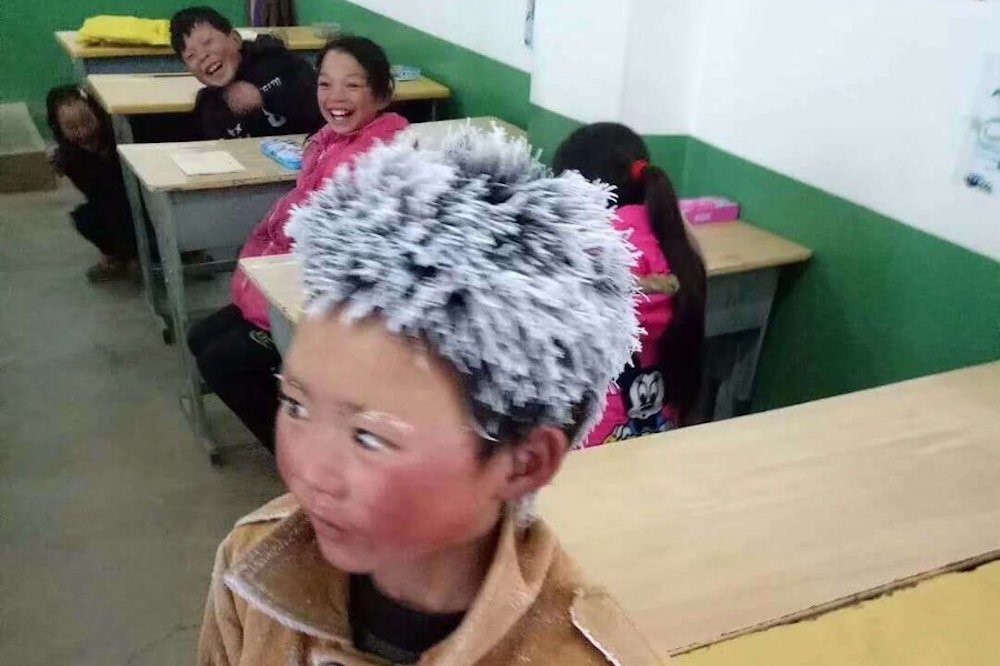
Wang Fuman, an 8-year-old boy from Ludian county in Yunnan province, walks a little over four kilometers to his school every day. On a cold winter morning, when he reached the Zhuanshanbao school he presented an unusual sight – the two hours walk through the frosty air had covered his hair and eyebrows with snow, and as a result, he bore a striking resemblance to a walking little snowman. This caused much amusement among his classmates and his school teacher, who snapped a picture of Fuman and posted it on WeChat.
The result of this WeChat posting opened the floodgates of sympathy and compassion for Wang Fuman. The netizens poured out their feelings for the hardship faced by the child walking through inclement weather to reach the school and the general adversity of his life in the village. It also reignited the frequent topic of the plight of “left-behind children” – whose parents are forced to leave them behind in villages while they head out to cities in search of a livelihood as migrant workers. The picture elicited unsolicited donation of several million yuan, the topic remained a subject of much sympathy and interest and ended up with the child and his father being invited to Beijing by the Legislative Affairs Committee of the CPC Central Committee.
While the average urban Chinese does not have to endure such hardship anymore, there are possibly millions who live in challenging circumstances in rural China (45% of the Chinese still live in villages). Their plight is often discussed in media (including social media) but does not generate the flood of compassion and financial help that the “frost boy” (as the netizens started calling Wang Fuman) succeeded in generating. Mother Teresa once said, “If I look at the mass, I will never act. If I look at the one, I will.”
This stirring of sympathy for vividly portrayed individuals, frequently seen in other such examples all over the world, is referred to as by the behavioral economists as the “identifiable victim effect”. The effect was first described by psychologist Paul Slovic, who conducted experiments to understand what moves people to loosen their purse-strings and contribute to worthy causes. In one experiment, half the participants were described the pitiable condition of a starving child called Rokia in Mali, and the other half were briefed about the statistics of starvation in Africa – including the fact that more than a million children are malnourished in Malawi and more than eleven million in Ethiopia need immediate food assistance. The average donation in the second group, who were exposed to the statistics was fifty percent lower than in the first group who were told the story of Rokia.
On the face of it, this is a very irrational response, and can only be explained by the concepts of behavioral economics, whose practitioners have often seen that quite often “more is less”. In this case, the plight of a single victim has a more powerful impact on the potential donors than a description of the similar condition of the millions. According to Slovic statistics, however impressive they may be, do not trigger our emotions and emotions are what makes us reach out and act.
The story of the “frost boy” has obvious implications on those who want to persuade the well-endowed to open their wallets and contribute to the needy. It also has huge implications for the marketers, who want to nudge the consumer to their brand. Consumers are more likely to be moved by stories of how individuals have benefited from the brand and how the brand has enriched the lives of identifiable consumers. than by statistics about the performance of the brand. The brand will touch the consumers better through vivid portrayals of individual people using and enjoying the brand, rather than it being proclaimed as the choice of millions. Similarly, when corporations want to demonstrate their efforts of CSR (corporate social responsibility) their efforts to convince the audience are likely to be more successful through vivid portrayals of contribution to identifiable individuals, rather than a bland description of their activities and how much they have spent on them.
For more on the implications of behavioral sciences on marketing, please join our next seminar in Shanghai.
Nudging the consumers to Your Brand
Rethinking marketing through the behavioral sciences lens
For registration please contact:

Hi, this is a comment.To delete a comment, just log in and view the post's comments. There you will have the option to edit or delete them.